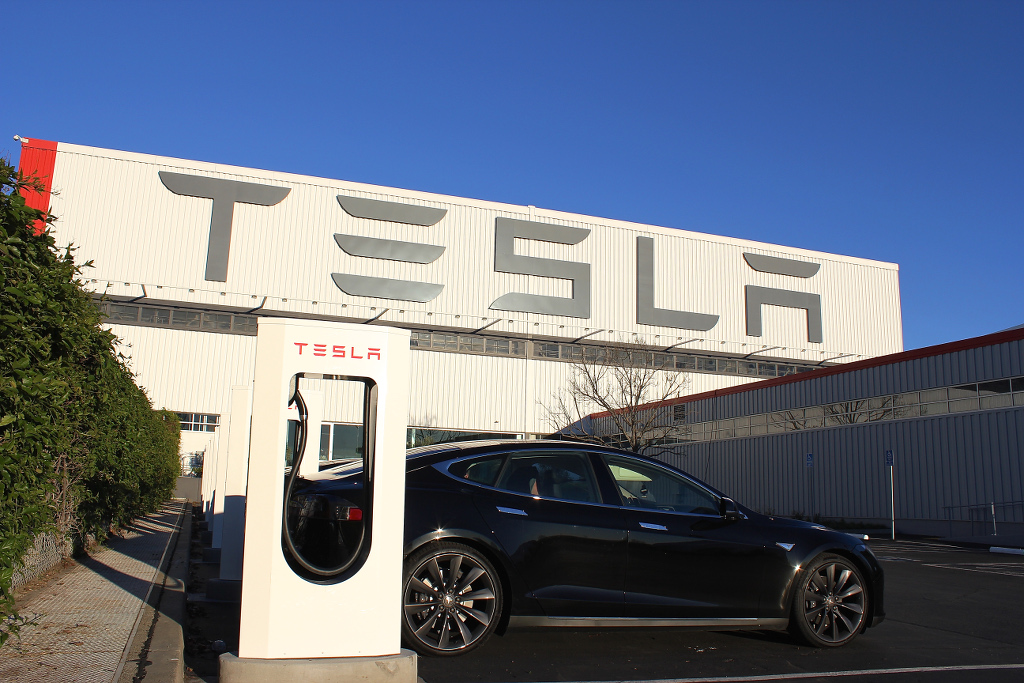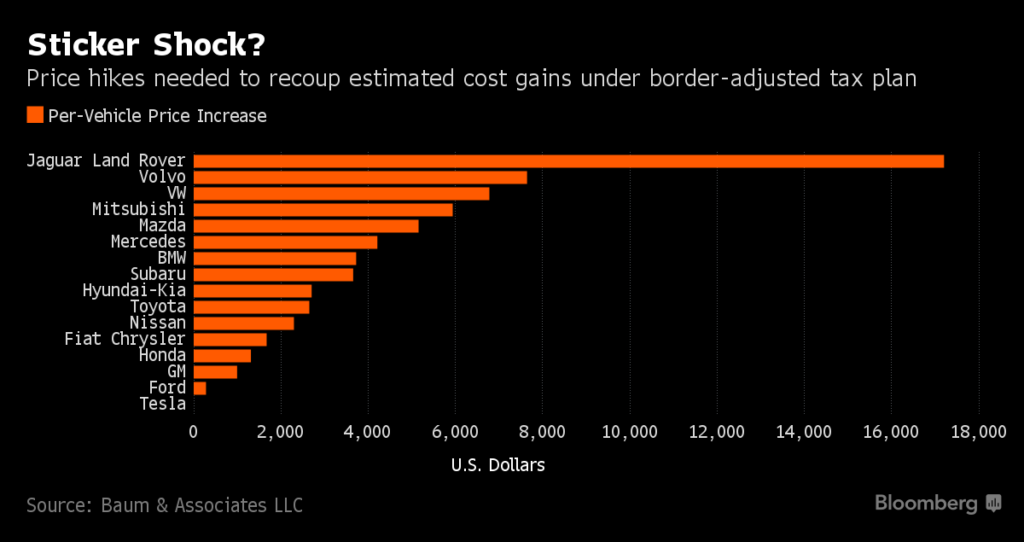News
Tesla on the winning end of proposed U.S. import tax

U.S. automobile sales might slow as a result of the proposed import tax affecting vehicles with manufacturers outside of the country. However, this change could stimulate up to 1 million additional vehicles could be manufactured in the U.S., which would add 50,000 more jobs at car production and part assembly plants.
That good news/ bad news scenario is according to researchers at Baum & Associates, LLC, which advises suppliers. Their report is intended to provide estimates to show the relative impact of the tax plan on each automaker. Dan Luria, an economist at the Michigan Manufacturing Technology Center in Ann Arbor, is the lead author of the Baum & Associates report, which accounts for imports of both finished vehicles and parts for domestic cars that are made overseas.
According to a report by Bloomberg, Tesla is the single automaker that would be able to maintain consistent pricing before and after such a tax implementation, as it manufactures all its cars in the U.S. and incorporates predominately U.S. made parts.
Border tax consequences for automakers
According to Baum & Associates, LLC, most automakers would need to raise vehicle prices by thousands of dollars. They would also likely have to assume a portion of the higher tax burden.
- Ford, with significant domestic manufacturing, would accrue the smallest price hike among major automakers, at about $282 per vehicle;
- General Motors Co. would experience a $995 increase per vehicle;
- Volvo and VW vehicle prices would have to rise by about $7,600 and $6,800, on average;
- Jaguar’s Land Rover, which is 100% imported, would require an increase of more than $17,000 per vehicle.
According to Alan Baum, the founder of the West Bloomfield, Michigan-based firm which produced the report, “The plan results in a net cost for automakers. Each company will then make its own decisions on pricing in order to best compete and maximize its profits.”
In what direction might a proposed border tax shift automakers’ current business practices? Essentially, the tax would create an incentive for automakers to keep U.S. plants running at the expense of those in Canada and Mexico. It could also steer auto companies currently conducting business in the U.S. to other markets.
- Automakers may boost U.S. parts procurement and production from existing vehicle assembly plants;
- Overseas automakers including Fuji Heavy Industries Ltd.’s Subaru, Mitsubishi Motors Corp., Mazda Motor Corp., Hyundai Motor Co., and Kia Motors Corp. may consider expanding existing U.S. operations or building new capacity;
- Volkswagen AG could build another U.S. assembly plant;
- Fiat Chrysler Automobiles NV may accelerate the conversion of factories in Michigan to build pickups there instead of Mexico;
- Nissan Motor Co. might export more from Mexico to Latin American markets and less to the U.S.;
- Mazda and Mitsubishi, which rely entirely on imports to the U.S. market, may have to quit the U.S. market or pay other manufacturers to assemble their cars.
Meanwhile, Toyota Motor Corp. is one of the corporations that is warning that the proposed border tax will result in many costlier products, not only in automobiles, but also in food, clothing, and gasoline, among other areas.
Other analysts weigh in on the effects of a proposed border tax
It’s not just Baum and associates who are advising clients on their prospective bottom lines should a border tax become legislated by U.S. officials. Other analysts are weighing in on the proposed border tax effects on commerce. Colin Langan, an analyst at UBS Securities LLC, argues that the proposed border tax could raise average prices in the U.S. by about 8 percent, or $2,500 per vehicle.
The border tax has the potential to reduce annual sales by about 2 million vehicles, Langan said.
He also projects that, while the tax has the potential to move through the House of Representatives, it is “very unlikely” to pass in the Senate. Langan predicts the chances of the border tax being enacted at less than 50 percent.
The proposal to begin levying companies’ imports and domestic sales and make exports tax-exempt would completely overhaul the U.S. tax code.

News
Tesla FSD fleet is nearing 7 billion total miles, including 2.5 billion city miles
As can be seen on Tesla’s official FSD webpage, vehicles equipped with the system have now navigated over 6.99 billion miles.

Tesla’s Full Self-Driving (Supervised) fleet is closing in on almost 7 billion total miles driven, as per data posted by the company on its official FSD webpage.
These figures hint at the massive scale of data fueling Tesla’s rapid FSD improvements, which have been quite notable as of late.
FSD mileage milestones
As can be seen on Tesla’s official FSD webpage, vehicles equipped with the system have now navigated over 6.99 billion miles. Tesla owner and avid FSD tester Whole Mars Catalog also shared a screenshot indicating that from the nearly 7 billion miles traveled by the FSD fleet, more than 2.5 billion miles were driven inside cities.
City miles are particularly valuable for complex urban scenarios like unprotected turns, pedestrian interactions, and traffic lights. This is also the difference-maker for FSD, as only complex solutions, such as Waymo’s self-driving taxis, operate similarly on inner-city streets. And even then, incidents such as the San Francisco blackouts have proven challenging for sensor-rich vehicles like Waymos.
Tesla’s data edge
Tesla has a number of advantages in the autonomous vehicle sector, one of which is the size of its fleet and the number of vehicles training FSD on real-world roads. Tesla’s nearly 7 billion FSD miles then allow the company to roll out updates that make its vehicles behave like they are being driven by experienced drivers, even if they are operating on their own.
So notable are Tesla’s improvements to FSD that NVIDIA Director of Robotics Jim Fan, after experiencing FSD v14, noted that the system is the first AI that passes what he described as a “Physical Turing Test.”
“Despite knowing exactly how robot learning works, I still find it magical watching the steering wheel turn by itself. First it feels surreal, next it becomes routine. Then, like the smartphone, taking it away actively hurts. This is how humanity gets rewired and glued to god-like technologies,” Fan wrote in a post on X.
News
Tesla starts showing how FSD will change lives in Europe
Local officials tested the system on narrow country roads and were impressed by FSD’s smooth, human-like driving, with some calling the service a game-changer for everyday life in areas that are far from urban centers.

Tesla has launched Europe’s first public shuttle service using Full Self-Driving (Supervised) in the rural Eifelkreis Bitburg-Prüm region of Germany, demonstrating how the technology can restore independence and mobility for people who struggle with limited transport options.
Local officials tested the system on narrow country roads and were impressed by FSD’s smooth, human-like driving, with some calling the service a game-changer for everyday life in areas that are far from urban centers.
Officials see real impact on rural residents
Arzfeld Mayor Johannes Kuhl and District Administrator Andreas Kruppert personally tested the Tesla shuttle service. This allowed them to see just how well FSD navigated winding lanes and rural roads confidently. Kruppert said, “Autonomous driving sounds like science fiction to many, but we simply see here that it works totally well in rural regions too.” Kuhl, for his part, also noted that FSD “feels like a very experienced driver.”
The pilot complements the area’s “Citizen Bus” program, which provides on-demand rides for elderly residents who can no longer drive themselves. Tesla Europe shared a video of a demonstration of the service, highlighting how FSD gives people their freedom back, even in places where public transport is not as prevalent.
What the Ministry for Economic Affairs and Transport says
Rhineland-Palatinate’s Minister Daniela Schmitt supported the project, praising the collaboration that made this “first of its kind in Europe” possible. As per the ministry, the rural rollout for the service shows FSD’s potential beyond major cities, and it delivers tangible benefits like grocery runs, doctor visits, and social connections for isolated residents.
“Reliable and flexible mobility is especially vital in rural areas. With the launch of a shuttle service using self-driving vehicles (FSD supervised) by Tesla in the Eifelkreis Bitburg-Prüm, an innovative pilot project is now getting underway that complements local community bus services. It is the first project of its kind in Europe.
“The result is a real gain for rural mobility: greater accessibility, more flexibility and tangible benefits for everyday life. A strong signal for innovation, cooperation and future-oriented mobility beyond urban centers,” the ministry wrote in a LinkedIn post.
News
Tesla China quietly posts Robotaxi-related job listing
Tesla China is currently seeking a Low Voltage Electrical Engineer to work on circuit board design for the company’s autonomous vehicles.

Tesla has posted a new job listing in Shanghai explicitly tied to its Robotaxi program, fueling speculation that the company is preparing to launch its dedicated autonomous ride-hailing service in China.
As noted in the listing, Tesla China is currently seeking a Low Voltage Electrical Engineer to work on circuit board design for the company’s autonomous vehicles.
Robotaxi-specific role
The listing, which was shared on social media platform X by industry watcher @tslaming, suggested that Tesla China is looking to fill the role urgently. The job listing itself specifically mentions that the person hired for the role will be working on the Low Voltage Hardware team, which would design the circuit boards that would serve as the nervous system of the Robotaxi.
Key tasks for the role, as indicated in the job listing, include collaboration with PCB layout, firmware, mechanical, program management, and validation teams, among other responsibilities. The role is based in Shanghai.
China Robotaxi launch
China represents a massive potential market for robotaxis, with its dense urban centers and supportive policies in select cities. Tesla has limited permission to roll out FSD in the country, though despite this, its vehicles have been hailed as among the best in the market when it comes to autonomous features. So far, at least, it appears that China supports Tesla’s FSD and Robotaxi rollout.
This was hinted at in November, when Tesla brought the Cybercab to the 8th China International Import Expo (CIIE) in Shanghai, marking the first time that the autonomous two-seater was brought to the Asia-Pacific region. The vehicle, despite not having a release date in China, received a significant amount of interest among the event’s attendees.









